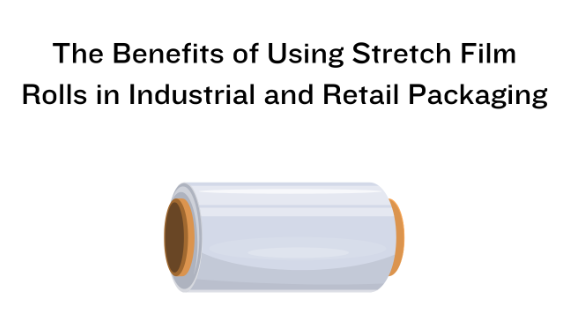Packaging is the backbone of any supply chain. Whether you're managing a bustling warehouse or ensuring products arrive safely on retail shelves, the role of effective packaging can't be overstated. For businesses in both industrial and retail sectors, packaging needs go beyond aesthetics—it's about protection, efficiency, and cost savings. That’s where stretch film rolls, a highly versatile and essential packaging material, come into play.
This blog will explore everything you need to know about stretch film rolls, from their types and core benefits to sustainable options that align with environmental goals. By the end, you’ll understand how these rolls can revolutionize packaging for your business.
What Are Stretch Film Rolls?
Stretch film rolls, often referred to as plastic rolls for wrapping, are thin, elastic plastic films designed to secure items during storage and transport. Made primarily from polyethylene, these films are both stretchable and durable, making them ideal for bundling products on pallets or securing irregularly shaped items.
Types of Stretch Film Rolls:
- Hand Stretch Film: Designed for manual wrapping. Perfect for smaller operations or packaging tasks that don’t require heavy-duty machinery.
- Machine Stretch Film: Designed for use with stretch wrapping machines, enabling faster and more consistent wrapping for high-volume operations.
- Pre-Stretched Film: A thinner and lighter option that is already stretched, reducing the effort needed during application while maintaining excellent load stability.
Unlike standard plastic wraps, stretch films are specifically engineered to stretch and cling tightly to the product surfaces—providing remarkable load stability and secure packaging without adhesives.
Key Benefits of Using Plastic Roll for Wrapping
Stretch film rolls offer several advantages that can transform industrial and retail packaging. Below are the top benefits:
1. Enhanced Load Stability and Security
Stretch film rolls are unmatched in their ability to keep items securely packaged. Whether you're stacking pallets or bundling odd-shaped goods, the elasticity of the film creates a tight seal that holds items in place. This minimizes shifting during transit and reduces the risk of product damage.
Example: A logistics company transporting fragile goods can rely on stretch films to prevent items from moving and breaking during transport.
2. Cost-Effective Packaging Solution
Using stretch film rolls significantly cuts down on packaging costs in multiple ways:
- Material Efficiency: Since stretch films can expand and cling tightly, less material is required compared to other wrapping methods.
- Compact Packaging: Their ability to bundle items tightly enables better loading efficiency, reducing space requirements on trucks or in storage.
By reducing material waste and optimizing transportation, companies can lower overall packaging expenses while maintaining high standards of protection.
3. Protection Against Moisture, Dust, and Contaminants
Stretch film acts as a barrier against external elements, making it indispensable for safeguarding products like food items, electronics, and industrial goods. The tightly bound film protects against humidity, dust, dirt, and other contaminants that could compromise product quality.
Example: Fresh produce suppliers use stretch films to wrap pallets and ensure their products remain clean and fresh from the warehouse to the store.
4. Improved Handling and Storage Efficiency
Stretch film rolls make it easier to manage warehouse inventory. The secure wrapping allows for neat stacking of pallets and improved organization while reducing the risk of tipping or product collapse during handling.
Additionally, stretch films enable quicker loading and unloading processes, saving time during warehouse operations.
5. Versatility in Industrial and Retail Applications
Stretch films are designed to cater to a wide range of industries and use cases:
- Manufacturing: Wrapping large machinery or components.
- Logistics: Palletizing goods for transportation.
- Supermarkets: Ensuring perishable products stay fresh.
- E-commerce: Safely bundling products for shipping.
Their ability to be customized based on thickness, elasticity, and clarity makes stretch films an ideal solution for both niche and large-scale applications.
Choosing the Right Stretch Film Roll for Your Business
Selecting the proper stretch film roll is critical to maximize efficiency and ensure your packaging needs are met. Here’s what to consider:
- Thickness: A thicker film provides greater durability, especially for heavy loads.
- Elasticity: Look for high stretchability to ensure a snug and secure wrap.
- Clarity: A clear film is ideal when visibility of the packaged product is necessary.
- Strength: Ensure the film can withstand pressure and handling without tearing.
Additionally, consider whether your business operations require hand wrap or machine wrap:
- Use hand wrap for smaller-scale operations where manual application suffices.
- Opt for machine wrap for high-volume workflows where speed and consistency are key.
Maximize Efficiency and Savings with Stretch Film Rolls
From securing delicate products during transport to enabling cost-effective operations in warehouses, stretch film rolls are a must-have for industrial and retail packaging. Their versatility, coupled with protection against environmental factors, is unmatched by other packaging solutions. What's more, the availability of eco-friendly options makes them a sustainable choice for businesses looking to minimize environmental impact.
If you want to improve efficiency, save costs, and protect your products, consider incorporating high-quality stretch film rolls into your packaging strategy. Whether you’re part of a logistics company or running a retail store, stretch films offer benefits you can’t afford to overlook.
